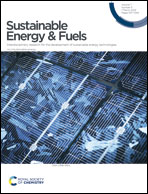Highly active Pd–ZrO2 electrodes for hydrogen evolution reaction†
Abstract
Here we discuss the use of a family of electrode materials, which exhibit specific electrocatalytic activity for hydrogen evolution reaction and hydrogen oxidation reaction. These composite materials show extended lifetime, also being very cheap in comparison with pure palladium. We specifically focus on composite electrodes formed by Pd and ZrO2, a ceramic oxide compatible with human tissues, whose role is to enhance the electroactivity of classic platinum group metals, thus significantly reducing the catalyst load. To carefully control the electrocatalyst composition and morphology, the electrodes are prepared by ion beam sputtering deposition onto fluorine-doped tin oxide supports, thus obtaining ordered layers of ceramic and electrocatalyst. The outcomes point to the synergistic effects between the precious metal catalyst and ceramic diluent not only in terms of the chemical stability of the layer but also of the electrochemical activity of the composite material.

- This article is part of the themed collection: Recent Open Access Articles


 Please wait while we load your content...
Please wait while we load your content...